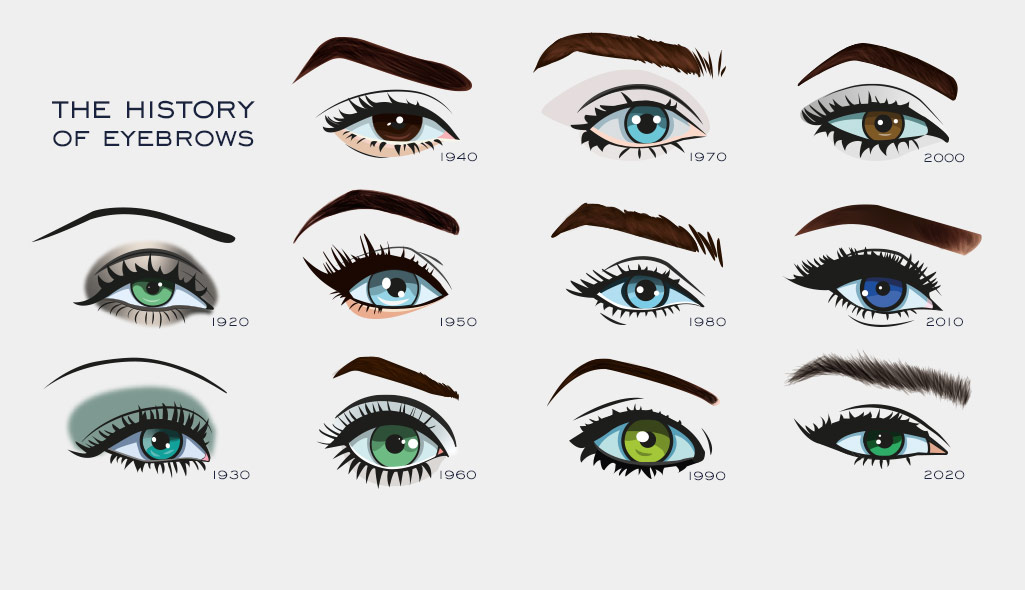
Pro Tips
The History of Eyebrows from the 1920s until Today
Keep in mind
Many of these styles would require reshaping in the form of waxing or plucking if you want to achieve a realistic/authentic look. In some cases, blocking of the brows would be needed if reshaping isn’t preferred.1920s Eyebrows: Defined, dark and thin

Women’s trademark in the golden era of the 1920s was not only flapper dresses and short bobs but also very thin, defined eyebrows with the tail of the brow sweeping down. The brow was slightly elongated past the natural end of the tail. If you want to recreate this look, an Eyebrow Pencil is the product to decide on. Map out the beginning of the brow and arch, marking points using a Faceliner in brown or black. For the end tail of the brow, apply your mark a little further out and down from today’s style. Then simply join the three markings with a single line of the same Faceliner. Keep in mind to draw the very beginning of the brow slightly thicker than the tail.
1930s Eyebrows: Extremely thin, rounded, and dark

In the 1930s, eyebrows became even thinner than in the 20s, with the same width at the start to the brow's tail, with a much more exaggerated and rounded, symmetrical arch. The space between the brow and eye looked larger. Using either Faceliner, Contour Pencil , or Cake Eye Liner are effective in recreating this style. A single opaque liner can be drawn in an almost half-moon effect that starts at the bottom line of the brow corner and smoothly curves up past the highest point of the natural arch and tails off slightly further than the usual marker of the corner of the eye.
1940s Eyebrows: Natural, thick, and rounded

Historically seen, the 1940s were a crucial decade. World War II and finally the end of it in 1945 marked the 1940s. Women desired a more natural look and started letting their eyebrows grow back. The trend was more towards thicker, rounded ones which were just gradually thinner at the tail. The brow's arch was much lower than in the 30s, almost sitting in the natural point, while the brow bone was slightly exaggerated. Colors suited the natural hair color and were not dense in the application. If you want to recreate this look, Eyebrow Powder is a good choice for this style. It’s soft yet buildable and perfect for recreating this natural soft color definition.
1950s Eyebrows: Defined, thick, and with a high angled arch

The 1950s marked the Golden Age of Hollywood with many feminine iconic actresses like Marilyn Monroe, Grace Kelly, and Jayne Mansfield. The eyebrow trend in this era were brows with a higher, angled arch. They became a little thicker than in the decades ago, with more definition and sharpness to the edges, carving out a very high angular arch. Irrelevant of hair color, the brows were dark and more defined than in the 40s. Apply Eyebrow Powder with an Angular Brush for precision and finish with a layer of Eyebrow Forming Gel to achieve this look.
1960s Eyebrows: Thicker at the front, thinner towards the end

The typical 60s brow was slightly thicker at the front. The tail end finished slightly shorter than the corner of the eye while at the same time higher above the brow bone. The coloring was more natural than in the 50s. Faceliner or Eyebrow Powder are perfect for recreating this look.
1970s Eyebrows: Very thin, overly plucked eyebrows

1970s trademark eyebrows were really thin and overly plucked, with a sharper and higher arch than in the 60s. Or in contrast, they were completely grown out and natural, without shaping or definition. Although very different styles, the unified trend was the hairs and coloring to be natural and not overly filled in. Once the style or shape has been achieved, Eyebrow Forming Gel is perfect for either of these extremes to achieve the accentuated, ‘natural hair’ look.
1980s Eyebrows: Natural and fluffy

Not only were fluffy hairstyles ‘in’ in the 1980s, but also fluffy brows. They looked very natural and were brushed up. This look can be achieved by using Eyebrow Powder and Eyebrow Forming Gel.
1990s and 2000s Eyebrows: Precisely plucked and thin

1990s was the decade of very thin, plucked/waxed brows with a soft arch, often finishing a little too short at the tail end. Faceliner or Contour Pencil are an excellent choice for this style of brow design. Eyebrows in the 2000s only had the difference that they were a bit thinner and brushed up.

2010s Eyebrows: Carved out, overly filled, and defined

Carved out and overly filled in as well as defined brows were the hit in the 2010 years. Brows in the 2010 years became thicker with high pointed arches and individually painted in hairs. Sharp angular edges were accentuated with lighter concealers to frame the hair’s color, often with a fading ombré color application, gradually getting darker towards the brow's tail. Use Eyebrow Powder and HD Cream Liner for the sharp edges and individually painted hairs to achieve this look.
Eyebrow Trend in 2021: Anything goes

Today, the eyebrow trend is towards “anything goes,” with a subtle lean towards the more natural, fluffy brow. Brushed-up ‘laminated’ brows are the height of the current trend. Seeing the brow hairs long, straight, and individually defined. Eyebrow Forming Gel or even brushed with Cine-Wax 40 g can help recreate this look.


